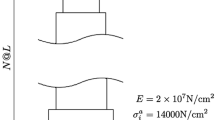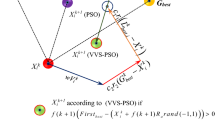Abstract
Steel structures are widely used; however, their traditional design method is a trial-and-error procedure which is neither efficient nor cost effective. Therefore, a multi-population particle swarm optimization (MPPSO) algorithm is developed to optimize the weight of steel frames according to standard design codes. Modifications are made to improve the algorithm performances including the constraint-based strategy, piecewise mean learning strategy and multi-population cooperative strategy. The proposed method is tested against the representative frame taken from American standards and against other steel frames matching Chinese design codes. The related parameter influences on optimization results are discussed. For the representative frame, MPPSO can achieve greater efficiency through reduction of the number of analyses by more than 65% and can obtain frame with the weight for at least 2.4% lighter. A similar trend can also be observed in cases subjected to Chinese design codes. In addition, a migration interval of 1 and the number of populations as 5 are recommended to obtain better MPPSO results. The purpose of the study is to propose a method with high efficiency and robustness that is not confined to structural scales and design codes. It aims to provide a reference for automatic structural optimization design problems even with dimensional complexity. The proposed method can be easily generalized to the optimization problem of other structural systems.
Similar content being viewed by others
References
Zhang Y, He Z. Seismic collapse risk assessment of super high-rise buildings considering modeling uncertainty: A case study. Structural Design of Tall and Special Buildings, 2020, 29(3): e1687
Lai X, He Z, Wu Y. Elastic inter-story drift seismic demand estimate of super high-rise buildings using coupled flexural-shear model with mass and stiffness non-uniformities. Engineering Structures, 2021, 226: 111378
Hervé Poh’sié G, Chisari C, Rinaldin G, Fragiacomo M, Amadio C, Ceccotti A. Application of a translational tuned mass damper designed by means of genetic algorithms on a multistory cross-laminated timber building. Journal of Structural Engineering, 2016, 142(4): E4015008
Ma L, Bai Y, Zhang J. Vertical deformation analysis of a high-rise building with high-position connections. Structural Design of Tall and Special Buildings, 2020, 29(15): e1787
Liu J P, Zhao M, Zhou J W. Seismic response of column supported tanks considering uplift effect and soil-structure interaction. Earthquake Engineering & Structural Dynamics, 2023, 52(5): 1578–1592
Pechorskaya S A, Galishnikova V V, Gebreslassie S B, Damir H Y. Structural analysis of high-rise building using ETABS and RSA software. Structural Mechanics of Engineering Constructions and Buildings, 2021, 17(2): 133–139
Zhao J, Zhen Z. PKPM and SAP2000 software on a layer of engineering aseismic structure performance analysis based on structure mechanics. Advanced Materials Research, 2013, 788: 498–501
Wang F, Shi Q, Wang P. Seismic behaviour of reinforced concrete frame structures with all steel assembled Q195 low yield buckling restrained braces. Structures, 2021, 30: 756–773
Shan W, Ding Y, Zhou J. Automatic structural optimization design using sensitivity-based method. Structures, 2022, 46: 99–108
Babaei S, Zarfam P. Optimization of shape memory alloy braces for concentrically braced steel braced frames. Open Engineering, 2019, 9(1): 697–708
Shen Y, Branscomb D. Orientation optimization in anisotropic materials using gradient descent method. Composite Structures, 2020, 234: 111680
Li Y, Duan R, Li Q S, Li Y G, Huang X. Wind-resistant optimal design of tall buildings based on improved genetic algorithm. Structures, 2020, 27: 2182–2191
Es-Haghi M S, Shishegaran A, Rabczuk T. Evaluation of a novel asymmetric genetic algorithm to optimize the structural design of 3D regular and irregular steel frames. Frontiers of Structural and Civil Engineering, 2020, 14(5): 1110–1130
Jarrahi H, Asadi A, Khatibinia M, Etedali S, Samadi A. Simultaneous optimization of placement and parameters of rotational friction dampers for seismic-excited steel moment-resisting frames. Soil Dynamics and Earthquake Engineering, 2020, 136: 106193
Degertekin S O, Hayalioglu M S, Gorgun H. Optimum design of geometrically non-linear steel frames with semi-rigid connections using a harmony search algorithm. Steel and Composite Structures, 2009, 9(6): 535–555
Gholizadeh S, Shahrezaei A M. Optimal placement of steel plate shear walls for steel frames by bat algorithm. Structural Design of Tall and Special Buildings, 2015, 24(1): 1–18
Gholizadeh S, Poorhoseini H. Seismic layout optimization of steel braced frames by an improved dolphin echolocation algorithm. Structural and Multidisciplinary Optimization, 2016, 54(4): 1011–1029
Çarbaş S. Optimum structural design of spatial steel frames via biogeography-based optimization. Neural Computing & Applications, 2017, 28(6): 1525–1539
Kaveh A, Khodadadi N, Azar B F, Talatahari S. Optimal design of large-scale frames with an advanced charged system search algorithm using box-shaped sections. Engineering with Computers, 2021, 37(4): 2521–2541
Talatahari S, Gandomi A H, Yang X S, Deb S. Optimum design of frame structures using the eagle strategy with differential evolution. Engineering Structures, 2015, 91: 16–25
Dadkhah M, Kamgar R, Heidarzadeh H, Jakubczyk-Galczyńska A, Jankowski R. Improvement of performance level of steel moment-resisting frames using tuned mass damper system. Applied Sciences, 2020, 10(10): 3403
Shishegaran A, Khalili M R, Karami B, Rabczuk T, Shishegaran A. Computational predictions for estimating the maximum deflection of reinforced concrete panels subjected to the blast load. International Journal of Impact Engineering, 2020, 139: 103527
Shishegaran A, Varaee H, Rabczuk T, Shishegaran G. High correlated variables creator machine: prediction of the compressive strength of concrete. Computers & Structures, 2021, 247: 106479
Shishegaran A, Saeedi M, Mirvalad S, Korayem A H. Computational predictions for estimating the performance of flexural and compressive strength of epoxy resin-based artificial stones. Engineering with Computers, 2023, 39(1): 347–372
Shishegaran A, Karami B, Safari Danalou E, Varaee H, Rabczuk T. Computational predictions for predicting the performance of steel panel shear wall under explosive loads. Engineering Computations, 2021, 38(9): 3564–3589
Karami B, Shishegaran A, Taghavizade H, Rabczuk T. Presenting innovative ensemble model for prediction of the load carrying capacity of composite castellated steel beam under fire. Structures, 2021, 33: 4031–4052
Liu R, Li J, Fan J, Mu C, Jiao L. A coevolutionary technique based on multi-swarm particle swarm optimization for dynamic multi-objective optimization. European Journal of Operational Research, 2017, 261(3): 1028–1051
Yazdani D, Nasiri B, Sepas-Moghaddam A, Meybodi M R. A novel multi-swarm algorithm for optimization in dynamic environments based on particle swarm optimization. Applied Soft Computing, 2013, 13(4): 2144–2158
Li W, Meng X, Huang Y, Fu Z H. Multipopulation cooperative particle swarm optimization with a mixed mutation strategy. Information Sciences, 2020, 529: 179–196
Han Y, Gu X. Improved multipopulation discrete differential evolution algorithm for the scheduling of multipurpose batch plants. Industrial & Engineering Chemistry Research, 2021, 60(15): 5530–5547
Nie W, Liu S, Yin H, Lu S, Zhao D, Xu H. Application of the improved multipopulation genetic algorithm in the TMD controlled system considering soil-structure interaction. Advances in Civil Engineering, 2022, 2022: 8212766
Farshchin M, Maniat M, Camp C V, Pezeshk S. School based optimization algorithm for design of steel frames. Engineering Structures, 2018, 171: 326–335
Farshchin M, Camp C V, Maniat M. Optimal design of truss structures for size and shape with frequency constraints using a collaborative optimization strategy. Expert Systems with Applications, 2016, 66: 203–218
GB 50011-2010. Code for Seismic Design of Buildings. Beijing: Standards Press of China, 2010 (in Chinese)
JGJ 99-2015. Technical specification for steel structure of tall building. Beijing: China Architecture and Building Press, 2015 (in Chinese)
GB 50017-2017. Standard for design of steel structures. Beijing: China Architecture and Building Press, 2017 (in Chinese)
American Institute of Steel Construction. Manual of Steel Construction: Load & Resistance Factor Design. 3rd ed. Chicago: American Institute of Steel Construction, 2001
Camp C V, Bichon B J, Stovall S P. Design of steel frames using ant colony optimization. Journal of Structural Engineering, 2005, 131(3): 369–379
Kaveh A, Talatahari S. An improved ant colony optimization for the design of planar steel frames. Engineering Structures, 2010, 32(3): 864–873
Degertekin S O. Optimum design of steel frames using harmony search algorithm. Structural and Multidisciplinary Optimization, 2008, 36(4): 393–401
Acknowledgements
This work was supported by National Natural Science Foundation of China (Grant Nos. 52308142 and 52208185), Postdoctoral Fellowship Program of CPSF (No. GZC20233334), Special Support of Chongqing Postdoctoral Science Foundation (No. 2021XM2039) and National Key Research and Development Program of China (No. 2022YFC3801700).
Author information
Authors and Affiliations
Corresponding author
Ethics declarations
Competing interests The authors declare that they have no competing interests.
Rights and permissions
About this article
Cite this article
Shan, W., Liu, J., Ding, Y. et al. Multi-population particle swarm optimization algorithm for automatic design of steel frames. Front. Struct. Civ. Eng. 18, 89–103 (2024). https://doi.org/10.1007/s11709-024-1037-7
Received:
Accepted:
Published:
Issue Date:
DOI: https://doi.org/10.1007/s11709-024-1037-7




